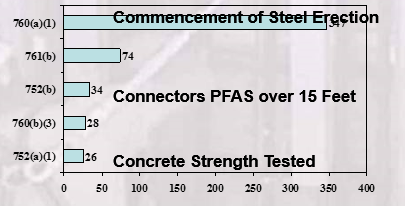 OSHA defines a willful violation as one “committed with an intentional disregard of or plain indifference to the requirements of the Occupational Safety and Health Act and requirements.” In 2015, there were 11 violations in this category for steel erection. According to a 2015 presentation by Paul Mangiafico, an OSHA Compliance Assistance Specialist with the Hartford, Conn., area office, 9% of fatal falls were from structural steel. He reports that most of these occur during commencement of steel erection, citing Subpart R 1926.760(a)(1). SEAA offers several resources to assist members in providing Fall Prevention training. Fall Hazard Training Module ($200 for members; $295 for non-members) was developed with training guidelines established by ANSI Z490.1-2001, and was last updated in 2014. The program is accompanied by a bilingual instructor’s guide, pre-planning checklist, discussion topics, and video. Among the topics covered:
Begin making plans now to participate in the Third Annual National Safety Stand Down to Prevent Falls in Construction, sponsored by OSHA, May 2-6, 2016. For more information and resources visit https://www.osha.gov/StopFallsStandDown/. The following Best Practices are intended to serve as a reminder to regularly re-visit fall prevention training for Ironworkers. OSHA standards represent a minimum level of safety. To protect all employees from falls at all heights, companies must establish training and protocol that exceeds the requirements, with a goal of zero injuries from falls, lower EMR, and happier and healthier employees. Best Practices Make fall prevention and protection an integral part of the whole project planning process. Develop a written, jobsite and hazard-specific plan. Employee orientation training and refresher training related to the specific job site hazards is a critical component of a good plan. Horizontal lifelines shall be designed, installed, and used, under the supervision of a qualified person, as part of a complete personal fall arrest system, which maintains a safety factor of at least two. Be aware of tripping hazards that can exist anywhere on the jobsite, including the steel structure. Take steps to mitigate or remove them as they arise. Select fall protection systems that are appropriate for the work and situation. Train workers in the proper selection, use, and maintenance of fall protection systems. Read more about planning and selection of fall arrest systems in this July 2015 Occupational Health & Safety magazine article by Marty Sharp, president of Ultra-Safe Inc. More Ironworkers should inspect their gear every day to make sure there is no damage to their fall protection equipment. Employees need proper training to recognize damage. Know the distance above which fall prevention or protection should be provided. Many states, contractors, and jobsites have established tie-off requirements at heights lower than Federal OSHA, such as at 6 feet. Guardrails are not necessarily anchorage points. You should never tie off to a guardrail or any horizontal cable unless you are sure it is designed to withstand the impact forces generated by a fall. Use colored flags or tape to identify if a guardrail is safe for tying off. Take steps to minimize free fall distance by tying off directly above the worker or keeping the anchorage point as close to the D-ring as possible. Take into consideration impacting structures below. The total fall distance is affected by the anchorage point, lanyard length, harness elongation, etc. When using retractable systems, always be aware of the pendulum effect. Protect life lines from burns, corrosives, and abrasion damage, such as sharp edges. Always have a rescue and retrieval plan with trained rescue personnel for every elevated job site. Workers hanging from a fall arrest system must be rescued in a safe manner, protecting the rescuer from falls, and quickly to prevent further injury. Comments are closed.
|



 RSS Feed
RSS Feed
